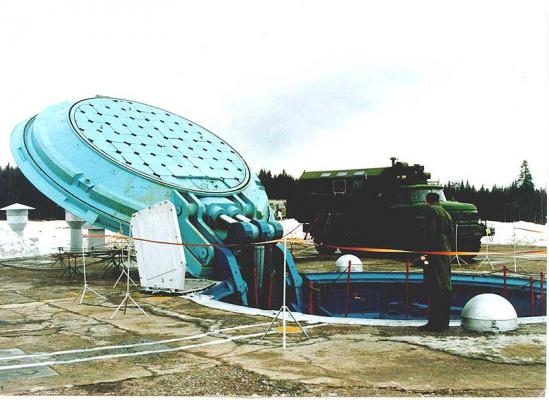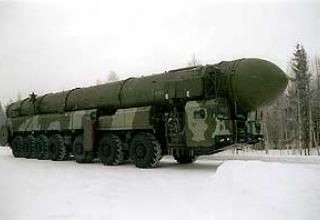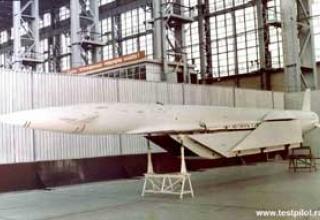In late 1993, Russia announced the development of a new domestic missile, designed to become the basis for a promising group of strategic missile forces. The development of missile 15Zh65 (RS-12M2), called "Topol-M", was carried out by Russian cooperation of enterprises and design bureaus. The leading developer of the missile complex is the Moscow Institute of Heat Engineering.
The Topol-M missile was created as a modernization of the RS-12M ICBM. The terms and conditions of the upgrade are defined by the START-1 Treaty, according to which a missile that differs from an existing one (analogue) in one of the following features is considered new:
- the number of stages;
- type of fuel for any of the stages;
- launch mass by more than 10%;
- the length of either the assembled missile without the head end or the length of the first stage of the missile by more than 10%;
- the diameter of the first stage by more than 5%;
- launch weight by more than 21 per cent combined with a change in the length of the first stage by 5 per cent or more.
Thus, the mass and dimensional characteristics and some features of the Topol-M ICBM design are strictly limited.
The stage of state flight tests of the Topol-M missile system was held at the 1-GIK MO. In December 1994, the first launch from the silo launcher took place. April 28, 2000. The State Commission approved the act on the adoption of the intercontinental ballistic missile "Topol-M" for the Russian Strategic Missile Forces.
Dislocation of units - regiment in Tatishchevo (Saratov region) (from November 12, 1998), at/h in Altai (Siberian, Pervomaiskiy region, Atai Territory). The first two missiles "Topol-M" /RS-12M2/ were put on trial duty in Tatishchevo in December 1997 after four test launches, and December 30, 1998 the first regiment of 10 missiles of this type went on combat duty.
The Topol-M missile manufacturer is the state enterprise Votkinsk Machine-Building Plant. The nuclear payload was created under the leadership of Georgy Dmitriev at Arzamas-16.
RS-12M2 Topol-M missile is unified with R-30 Bulava advanced missiles designed for arming strategic nuclear submarines of project 955.
In the west, the complex was designated SS-X-27.
Composition:
The 15Zh65 missile is operated as a stationary (15P065) and mobile (15P165) missile systems. In this case, the stationary version uses silo launchers (SHU) of missiles removed from service or destroyed in accordance with the START-2 Treaty. The stationary version is based on the conversion of the 15A35 medium-range ICBMs (developed by the Vympel Design Bureau) and the 15A18M heavyweight ICBMs (developed by the KBM).
The 15P065 combat stationary silo missile system includes 10 15Zh65 missiles in the 15P765-35 silo launchers and one high-security unified command post of the 15B222 type (placed on a suspension in the mine by means of special depreciation). The application of the "mortar launch" allowed to significantly increase the resistance of the 15P765-35 SHPU to PFYAV by removing the elements of the 15P735 launch unit necessary for the gas-dynamic launch of 15A35 missiles, using an improved amortization system and filling the released volume with special grades of heavy reinforced concrete. The Vympel Experimental Design Bureau, headed by Dmitry Dragun, carried out work to re-equip the 15P735 silo launchers to accommodate Topol-M missiles.
In accordance with the START-2 agreement, it is permitted to convert 90 15A18 ICBMs to 15Zh65 missiles, while ensuring that no heavy ICBMs can be installed in such a converted vehicle. Refinement of these SHU includes pouring a 5m layer of concrete on the bottom of the mine, as well as installing a special restrictive ring in the upper part of the launcher. The internal dimensions of the heavy missile shaft are excessive to accommodate a Topol-M missile, even taking into account the pouring of the lower part of the PC with concrete. The mass of the "Topol-M" missile, its outer diameter and length is less than the mass geometric dimensions of the 15A18M missile, respectively, about 5, 1.5 and 1.5 times. In order to preserve and apply for the conversion of aggregates and systems of heavy slurry, it was necessary to conduct a number of complex studies of the loading scheme of slurry at the launch and the launch, the service system, the impact on the gas dynamics of the launch of a large internal free volume of the mine, the limiting ring and a massive and large-size roof, the loading of the TPC with the missile in the PU, etc.
Resource-saving technology in the creation of serial PU 15P765-18 provides for the preservation of the protective roof, barbett, drum, shaft with the bottom directly at the facility and the reuse of most of the equipment PU 15P718 - drives the protective roof, depreciation system, elevators and other equipment - after their dismantling, sending to the manufacturing plants, conducting RWR at plants with testing on the stands. The problem of resource-saving technology implementation is closely connected with setting new warranty terms for reused equipment, including the shaft. Placement of Topol-M missiles in the modified in this way existing control gears allows to significantly reduce the costs of development and deployment of the complex. Successful flight tests (see photo - 26.09.2000, site 163/1 "Yubileinaya") allowed the State Commission to recommend for adoption into service as a part of the SHU rocket complex, converted from SHU heavy missiles and already in summer 2000 such complex was adopted by the Decree of the President of the Russian Federation.
The 15P065 Battle Missile System (BMD) with the 15G65 light class solid-propellant ICBM, which is highly resistant to PFN, provides for the launch of the missile without delay to normalize the external environment in case of multiple nuclear effects on the adjacent BMD facilities and in case of blocking of the position area by high-altitude nuclear explosions, as well as with minimum delay in case of non-porous nuclear effects directly on the launcher. The stability of the PU and the mine command post to PFNBR has been significantly increased, and there is a possibility of launching from the permanent alert mode on one of the planned target designations, as well as operational re-targeting and launching on any unscheduled target designation transferred from the top management level. The probability of bringing the launch teams to the control and control points has been increased. During the combat duty 15Zh65 missile is in a metal transport and launch container. The TLCs are unified for both types of SLCs.
The transport installation unit of the complex (see photo), created in KB "Motor", combines the functions of an installer and a transport and loading machine.
See on our website: Loading into the shaft of the intercontinental ballistic missile system RT-2PM2 "Topol-M".
Mobile Topol-M ICBMs are deployed as part of the 15P165 DBK. The 15Zh65 mobile missile is deployed on the eight-axis MZKT-79221 (MAZ-7922) high cross-country capability, a high-strength fibreglass plastics engine, and is virtually identical to the mine version. Weight of the launching unit - 120 tons, length - 22 meters, width - 3.4 meters. Six pairs of wheels of eight are turning, which provides a turning radius of 18 meters. Ground pressure of the unit is half as low as that of a conventional truck. The PU engine is a V-shaped 12-cylinder turbocharged diesel engine YAMZ-847 with an output of 800 hp. Depth of ford is up to 1.1m. At creation of systems and units BRK 15P165 "Topol-M" a number of essentially new technical decisions in comparison with complex "Topol" are used. Thus, the system of incomplete hanging makes it possible to deploy PU "Topol-M" even on soft soils. Permeability and maneuverability of the installation has been improved, which increases its survivability. "Topol-M" is able to make launches from any point of the position area, and also has improved means of camouflage both against optical and other means of reconnaissance (including by reducing the infrared component of the demasked field of the complex, as well as the use of special coatings that reduce radar visibility).
The 15Zh65 missile has three marching stages plus a stage of diluting combat units. All stages are solid fuel. The marching steps have an all-metal body of type "cocoon" from a composite material. Unlike its predecessor "Topol" 15Zh65 has no lattice stabilizers and rudders. Flight control at the first stage is implemented by a central pivoting partially recessed nozzle based on an elastic joint. The length of the first stage - 8.04m, diameter - 1.86m, weight of fully equipped first stage - 28.6t RDTT of the first stage at sea level - 890000kN. The second and third stages are equipped with a central pivoting partially recessed nozzle with folding nozzle head. Nozzle blocks of all stages are made of carbon-carbon material, nozzle liners - on the basis of three-dimensional reinforced oriented carbon-carbon matrix. Diameter of the second stage is 1.61m, diameter of the third stage is 1.58m.
Control system - inertial based on BCVC and gyrostabilized platform. The complex of high-speed command gyroscopic devices has improved accuracy characteristics, the new BCVK has increased productivity and resistance to the effects of fossil fuels, sighting is provided due to the implementation of autonomous determination of the control element azimuth, installed on a gyrostabilized platform, using the ground complex of command devices, placed on the TPK. Improved combat readiness, accuracy and service life of the on-board equipment were ensured.
The high performance of the 15Zh65 missile in ensuring a high level of resistance to nuclear blast threats was achieved through the application of a set of measures that had already proved successful in building R-36M2 (15A18M), RT-23UTTH (15Zh60) and RT-2PM (15Zh58) ICBMs:
- use of a newly developed protective coating applied to the outer surface of the missile body that provides comprehensive protection against PSNF;
- the use of a control system developed on the element base with increased resistance and reliability;
- application of a special coating with a high content of rare-earth elements on the case of an airtight instrument compartment in which the SU equipment was located;
- application of shielding and special methods of laying the missile's onboard cable network;
- introduction of a special program manoeuvre of the missile when passing a cloud of ground nuclear explosion, etc.
Successful measures have been taken to shorten the flight time and reduce the altitude of the endpoint of the missile's trajectory. The ICBM has also been given the opportunity for limited maneuverability in the boost phase of the trajectory, which makes it possible to significantly reduce the probability of an impact on the most vulnerable, initial flight section. According to the developers, the Topol-M ICBM's active flight area (launch, work area of marching stages, deployment of combat equipment) has been reduced to "3-4 times" as compared to liquid-propellant ICBMs, for which it takes about 10 minutes.
Head unit type: detachable monoblock thermonuclear unit with high speed, high level of resistance to PFU, combat unit. In the future it is possible to equip the missile with a maneuvering HC or a separating HC with the number of combat units from 3 to 6 (the prospective 150 kt RSH IN combat units are unified with the D-19M complex with R-30 "Bulava" SLBMs). The first test launch of a mobile version of the Topol-M ICBM equipped with MRBMs with individual guidance combat units (the official name of the new missile is RS-24) took place on May 29, 2007 from the Plesetsk launch site.
It should be noted that the BC for Topol ICBMs was created with maximum use of experience and technologies obtained during the development of the BC for Topol ICBM, which made it possible to reduce development time and costs. Despite this unification, the new BC is much more resistant to ABI and the action of weapons based on new physical principles than its predecessor, has a lower specific weight and has improved mechanisms to ensure security during storage, transportation and standby. The new BC has an increased share of fissile material efficiency compared to its predecessor and is historically the first domestic BC for ICBMs to be built without testing parts and assemblies during in situ nuclear explosions.
The 15G65 missile is equipped with a new missile breakout system (BMDBS). The BMDBS consists of passive and active decoys (LC) and means of distortion of the head unit characteristics. The LCs are indistinguishable from combat units in all ranges of electromagnetic radiation (optical, laser, infrared, radar), they allow to simulate the characteristics of combat units in almost all the selection features on the exoatmospheric, transient and a significant part of the atmospheric section of the descending branch of the missile's flight path, are resistant to the damaging factors of a nuclear explosion and to the radiation of a high-powered nuclear-pumped laser, etc. The LCs can be used to simulate the characteristics of combat units. For the first time there were designed LCs capable of withstanding superresolution radars. Means of distortion of the head part characteristics consist of radio-absorbing (combined with heat-protective) RF cover, generators of active radio interference, aerosol sources of infrared radiation, etc. The BMDBS is designed to significantly increase the time required for the prospective BMD of a likely adversary to detect the RF among a multitude of false targets and interference, thus significantly reducing the probability of the RF intercept. According to some data, the mass of the Topol-M ICBM BMD SLBM exceeds that of the American LGM-118A "Peacekeeper" ICBM. In the future, if the missile is equipped with a maneuvering head unit (or a separating head unit with individual guidance warheads), the missile defense capabilities of a likely adversary to intercept HC will, according to Russian experts, be reduced to almost zero.
The characteristics of RK "Topol-M" make it possible to significantly increase the readiness of the Strategic Missile Forces to carry out combat missions in any conditions, to ensure maneuverability, stealth and survivability of units, subunits and individual launchers, as well as reliability of control and autonomous operation for a long time (without replenishment of material resources). Aiming accuracy was almost doubled, accuracy of geodetic data determination was increased by one and a half times, preparation time for launching was halved.
Re-equipment of the Strategic Missile Forces units is carried out using the existing infrastructure. The mobile and stationary versions are fully compatible with the existing combat control and communications system. The guaranteed service life of ICBMs 15J65 is 15 years (20 years for some data).
Characteristics:
| Maximum range of fire, km | 11000 |
| Number of steps | 3 |
| Start mass, t | 47.1 (47.2) |
| Abandoned mass, t | 1,2 |
| The length of the missile without the head end, m. | 17.5 (17.9) |
| The length of the rocket, m | 22.7 |
| Maximum housing diameter, m | 1,86 |
| Header type | monoblock, nuclear |
| Warhead equivalent, mt. | 0.55 |
| Circular probable deviation,m | 200 |
| Diameter of TIC (without protruding parts), m | 1.95 (for 15P165 - 2.05) |
| MZKT-79221 (MAZ-7922) | |
| Wheel formula | 16x16 |
| Turn radius, m | 18 |
| Traffic clearance, mm | 475 |
| Weight in equipment (without combat equipment),t | 40 |
| Load capacity,t | 80 |
| Maximum speed, km/h | 45 |
| Power reserve, km | 500 |
Testing:
On February 9, 2000 at 15:59 Moscow time the Russian Strategic Missile Forces (RSF) successfully launched the Topol-M intercontinental ballistic missile from the 1st State Test Cosmodrome "Plesetsk". The Topol-M intercontinental ballistic missile (RS-12M2) was launched from the Kura combat field located in Kamchatka. The missile hit a training target in the specified area.
On September 20, 2000 the RS-12M2 missile was first launched from a mobile launcher.
April 20, 2004 at 21:30 Moscow time, the joint combat calculations of the Strategic Missile Forces and the Russian Space Forces from the Plesetsk Cosmodrome conducted another test launch of intercontinental ballistic missile (ICBM) "Topol-M" with a self-propelled launcher according to the plan of flight tests in the interests of the Strategic Missile Forces. This was the first launch in the last 15 years into the water area of Hawaii with a range of more than 11 thousand kilometers.
On December 24, 2004, the Topol-M missile was successfully launched from a mobile launcher. The launch was made at 12:39 Moscow time from the Plesetsk test site. The head part of the missile reached its intended target at the Kura test site in Kamchatka at 13:03 Moscow time. The launch was the fourth and final launch of the mobile version of the Topol-M complex, conducted as part of tests of the complex.
On November 1, 2005 the successful test launch of the RS-12M1 Topol-M rocket with a maneuvering head end was conducted from the Kapustin Yar test site in the Astrakhan region. This was the sixth launch as part of the testing of the system designed to overcome the American missile defense. It was launched at the tenth Balkhash test site in Kazakhstan (Priozersk).
Sources:
- "КБ специального машиностроения: От артиллерийских систем до стартовых комплексов" (под редакцией Ушакова В.С.) .СПб, 2004
- М.А.Пашнев "Тополь-М: история создания и перспективы"
- "Тополь-М" вытесняет "Молодца" И "Воеводу"
- http://www.cf.ru/dippela/
- Николай Соков "Эволюция российских стратегических наступательных вооружений"







